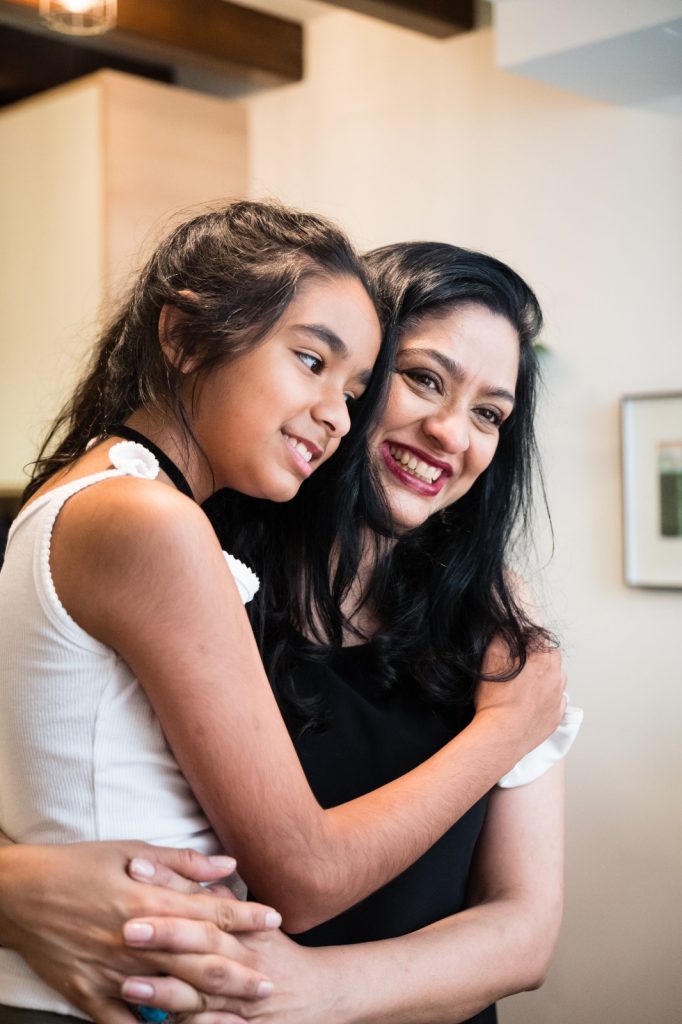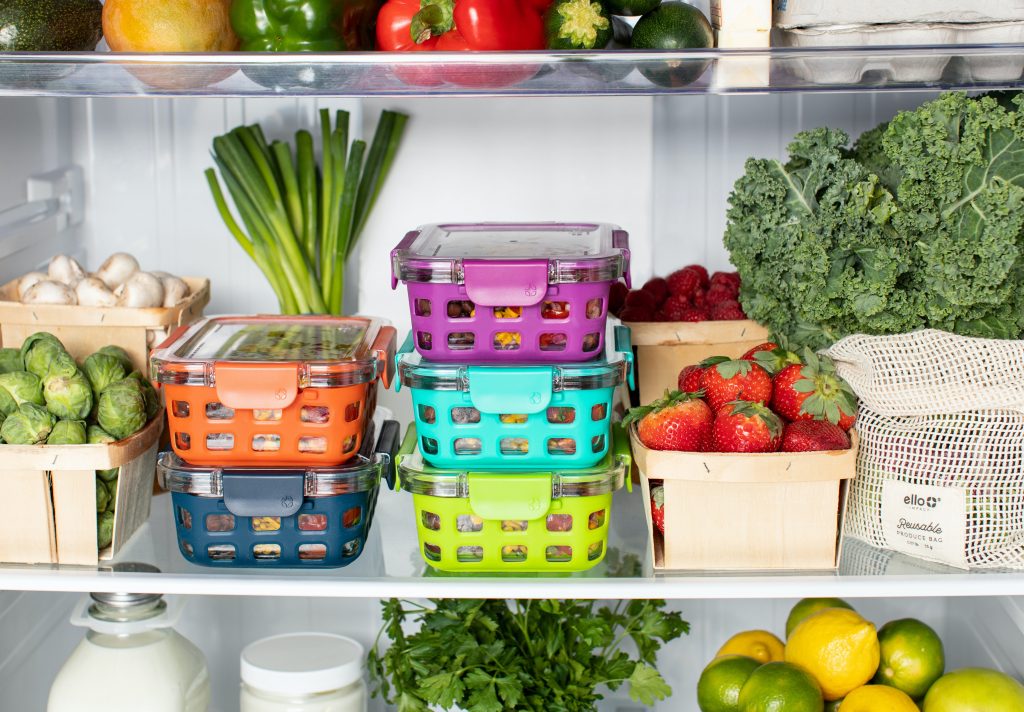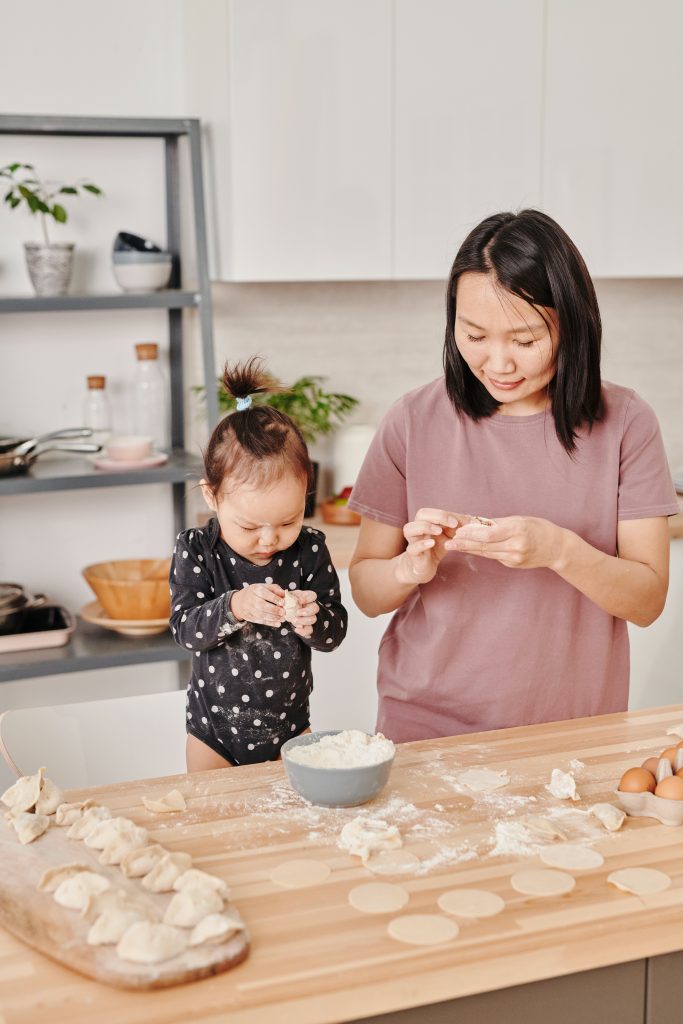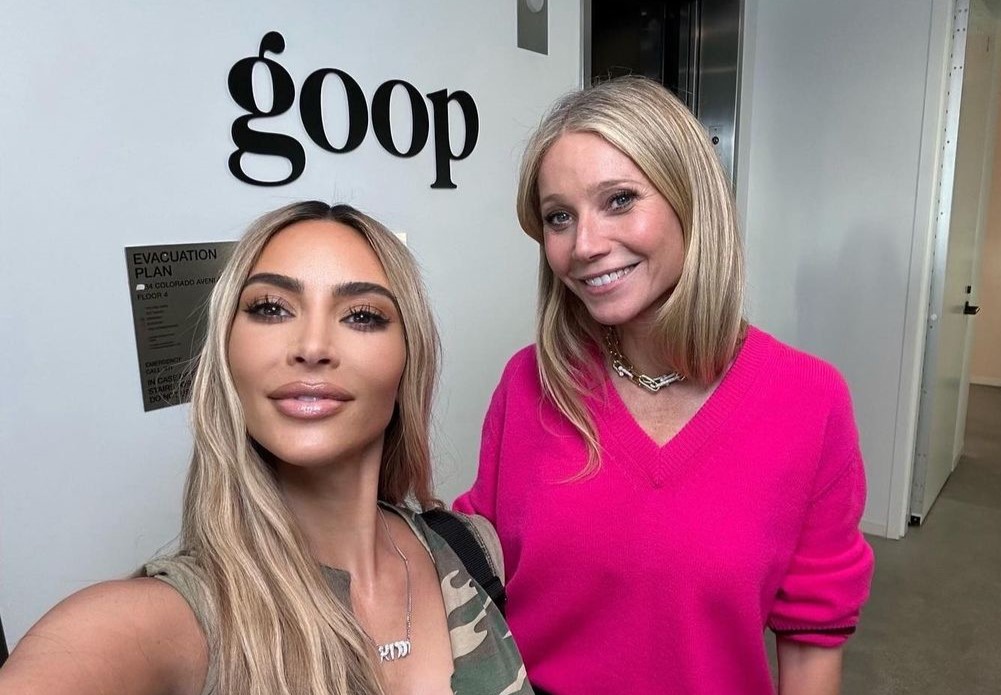Like everyone else, I was appalled when I read about Gwyneth Paltrow’s diet; after all coffee, or celery juice with water is a drink, not breakfast. A further listen into the Art of Being Well podcast with Dr Will Cole provided a little relief. At least she did have one substantial meal a day; something frequently glossed over by the TikTokkers and dieticians who fairly decried her diet as being restrictive and an example of disordered eating.
Together with our expert nutritionists, we’ll look into Gwyneth Paltrow’s diet that has caused so much uproar, and quick hacks to make healthy meals less of a hassle. Additionally, parents of two, and co-founders of Thrive Fitness share their top tips for helping the whole family have a balanced diet.
The Gwyneth Paltrow Diet As Per the Podcast
Gwyneth Paltrow’s interview with Dr Will Cole. TikTok video courtesy of Dear Media
In the podcast, she says her diet starts with a coffee, celery juice with lemon or lemon water at 12pm, followed by soup or bone broth most days. In the evening, at around 6 – 6.30pm, she told Dr Will Cole, “I try to eat according to Paleo so lots of vegetables”, usually from farmer’s markets and local farms. Together with these, she also eats “any kind of fish or birds.” Gwyneth adds, “We try to get a little bit clever with carbohydrates, like sweet potato noodles, or we make tacos with the siete grain free tacos, and cassava.” She added that she uses lots of flavorful ingredients, and said that her friends have no idea “they’re eating healthy food or that it’s Paleo.”
She has since clarified in an Instagram Story that she’s been eating a lot more than just bone broth and vegetables. Her diet helps lower inflammation and includes cooked vegetables, all kinds of proteins and healthy carbs.
Analysing Gwyneth Paltrow’s Diet
The Experts

Dr Naras Lapsys, dietitian/nutritionist at Integrative Medical Centre completed a PhD in molecular genetics and then began a career as a research scientist investigating obesity and diabetes at the Garvan Institute of Medical Research. Later, he returned to university to obtain his Masters degree in nutrition and dietetics. He later became Board certified in both the USA and Australia in regenerative and anti-aging medicine. The father of two children, 10 and 13, now runs a bespoke nutrition and longevity consultancy.

Pooja Vig, the CEO and Functional Medicine Nutritionist of The Nutrition Clinic, has a Bachelor of Science with Honors in Microbiology, and the Dr Kalish Functional Medicine Mentorship. Her journey began when her family worked together with Johns Hopkins Hospital to tackle her father’s illness with a range of disciplines now known as integrative medicine. She began ‘biohacking’ after being told that conceiving would be difficult, thus improving her low energy and immunity, poor digestion and sleeping patterns. Additionally, she’s also the mother to a beautiful girl.
The Analysis of Gwyneth Paltrow’s Diet
Pooja Vig
Pooja Vig says, “Fundamentally, there is nothing wrong with the components of what she eats – but it is way too little food! There is also nothing wrong with fasting primarily, but women in particular need to know when and how to do it properly.” She adds that it can “really affect hormones and fertility”. On bone broth, she says it’s an “excellent super-food and many of our clients have it as part of their meals”. While following paleo-style eating “can work very well for digestion and blood sugar, but in her case, that seems like the one proper meal she is having in the day.” Pooja adds, “At the root of the issues is that there is so much noise around extreme diets and restriction.” She also says, “It has to be said that there is also a lot of pressure to look a certain way, which feeds into this.”
Dr Naras Lapsys
Dr Naras Lapsys observes that Gwyneth Paltrow is very lean and likely to be conscious about her weight, and uses intermittent fasting to continue to keep her nice and lean. For the sake of brevity, I’ve condensed his very detailed analysis into the following points. The upside of her diet is that she’s getting lots of micronutrients from the locally sourced vegetables and she’s also having mostly whole foods. However, his main issue with Gwyneth Paltrow’s diet was that she appeared to only be having a single meal a day with a sizable calorie load with carbohydrates and proteins. Hence, she’d likely not be getting enough macronutrients. Dr Naras elaborates, “It’s the only time of the day that she’s really eating protein, and there’s absolutely no doubt that her protein needs would be on the low end.” He adds that if her main sources of protein were fish and birds, that’s “quite a restrictive range of protein.”
Importance of a Balanced Diet

Pooja defines a balanced diet as one that “includes all the macro and micro nutrients you need to thrive.” It also takes into account “your genetic makeup, lifestyle and food sensitivities.” She says, “A good balanced diet should provide all your essential nutrients such as carbohydrates, proteins, fats, vitamins and minerals.” These nutrients are essential to maintain good health, while preventing various illnesses and diseases. A balanced diet should also help manage a healthy weight, and improve mood and your energy levels. Conversely, eating too much food from unhealthy sources can lead to weight gain and related health problems. Likewise, foods high in sugar and unhealthy fats may cause mood swings and energy crashes.
Portion Sizes and Macronutrients
Dr Naras suggests customising portion sizes according to your age, activity level and body type. A balanced eating pattern needs to have a good balance of proteins, carbohydrates, fats and oils, micronutrients and the antioxidants. As a guide, Dr Naras recommends eating about your palm size to 3/4 hand size of protein during your main meals. Eating this much – whether plant or animal protein – will get you close to your protein needs.
Your carbohydrate based foods should be roughly the size of your fists. These should include potato, sweet potato, brown or wild rice, quinoa, wholegrain products, rice and pasta. For the rest of the meal, you should have lots of seasonal fresh vegetables with lots of colours and skin.
The Dangers Of Restrictive Eating
Dr Naras says, “When you have a restrictive diet, quite often you’re completely eliminating entire food groups.” As a result, you may be lacking in key micro and macronutrients, and can be quite psychologically restrictive. He explains, “You can’t have the flexibility to eat in a particular way because you’re now caught in that one front.” He also recommends looking at the science and medicine behind it. Marketing or social media messages are often not backed by a lot of scientific evidence. Dr Naras says, “It could be extremely unhealthy even if it is giving you the short term things you are looking for.” While you may lose a lot of weight, for example, there may be some drawbacks. These include a dangerous blood profile perspective, iron deficiency, and low energy. You might also be at high risk of osteopenia, osteoporosis or a bone mineral density issue.
Pooja also agrees that “social media can be really harmful – we have seen clients following all kinds of bizarre and restrictive diets that lead to longer term consequences.” Even diets like becoming vegan can have risks if not executed well. She says she sees “clients who have digestive issues, low energy and mood after moving to a vegan diet.” She recommends not removing main food groups unless there’s a good reason – and supplement for any deficiencies.
Tips For Having A Balanced Diet For Busy Mums

Parents of two children under three, Matthew and Brie Benfell are also the co-founders of Thrive Fitness. He says, “My go to easy tips for mums to have a balanced diet are pretty un-sexy to be honest!” These include keeping things simple: getting plenty of protein, veggies and fruits and hydrating. They also don’t believe in demonising foods or overcomplicating things. He says, “Relax and enjoy your favourite foods in balance.”
Eating Out or Food Delivery
As a guide, Pooja recommends starting every meal “with a vegetable dish or salad, and then build for there – this has a great impact on our blood sugar levels.” Dr Naras further elaborates, “If you do choose to eat out or use a food delivery service, opt for less processed foods – and the food should look not very much different from its base source.”
Shortcuts - Batch Cooking or Freezing Meals
Don't become the final stop for your kids' food - we often see mums eating what their kids don't. This may add a lot of additional - often carbs - to your diet.
Pooja Vig
Pooja and Dr Naras both recommend planning ahead and being organised. Pooja suggests using “frozen veggies, like mushrooms or spinach, with eggs” for a great quick dinner. Additionally, Dr Naras says, “Batch cook food, put it into the freezer straight away – it’s nice and safe.” Heat these up well, and have these the next day. Similarly, cook up trays of vegetables, store them in the fridge and they’ll last for several days.
Have Ingredients On Hand and Quick Go-To Meals
Dr Naras also suggests shopping frequently and loading up your crisper drawer full of vegetables and nice fresh fruit. Additionally, be sure to get a wide variety of protein – a lot of these can sit in the freezer. I personally suggest taking a little time to chop or mince onions or garlic, peel carrots and store them in individual containers. When it’s time to cook, you can easily throw them into the pot or pan. Next, research quick meals that can be ready in 20 – 30 minutes with these ingredients. Air fryers or pressure cookers can help you quickly cook and prepare food.
Impart Healthy Eating Habits to Our Children
One thing we do is try to incorporate a wide variety of foods for our kids to try. We do not demonise foods or pass on silly moral attachments to food groups. We try and eat with our kids where we can as a family at the table. Our children eat more or less like we do so they get protein and a balanced diet where possible. Allow balance with things like sugar and super palatable foods. We don’t stress out, even though it can be challenging at times!
Matthew and Brie Benfell
Eating as a Family
Children also need to be pushed a bit with a patience after the age of two. It can take kids 20-30 (or more) tries or refusal of something before they do. So keep going.
Pooja Vig
The first step is to eat as a family. The kicker? No screens – admittedly I find this hard too. Pooja says, “Start there! So many people don’t eat with their kids or sit in front of the television or a device.” Dr Naras concurs, “We actually have to spend time and actually have to talk to one another. And then by setting an example we’re all eating together. Then you’re showing that it’s important to eat like this because this is how we choose.” Personally, he tries to get his children to try different things so they don’t eat the same thing day after day. An additional benefit? Children see what you’re eating and may want to try what’s on your plate too.
Get Them Involved

Dr Naras also says, “Personally I actually have them involved in the shopping process so I like to have them come with me to the markets.” This way, they can help “choose the foods so they’re prepared to try something else.” Adding to that, Pooja recommends, “Get into the kitchen as a family as early as you can too – getting kids to cook, chop, mix involves them in the process and increases the chance of them being more experimental.” Personally, I’m adverse to letting my two year old handle any sort of sharp implement, but he has great fun dumping the ingredients into the Instant Pot. He just has yet to grasp the concept of needing heat to cook said food.
Our Nutritionists’ Daily Diets
Pooja Vig
Pooja cautions, “there is no perfect diet.” She says what works for her is based on her genetic makeup, her current lifestyle and stage of life. On most days, she does intermittent fasting, and lunch is her biggest meal – usually a large salad with protein, typically with a fermented vegetable. For dinner, she has a “warm meal with a focus on vegetables and protein.” While she avoids refined grains and limits sugar, she really enjoys coffee. She sticks to one cup, with a dash of milk – oat milk spikes her blood sugar, and almond milk coffee doesn’t work for her.
She explains that she eats this way because she has “genetics that lend themselves to high blood sugar”. Pooja enjoys eating like this, and she never feels deprived. She says, “Food ultimately is joy – and it is important to feel joyful about food.” Every now and again, she says, she has a treat, as her work over the years on her microbiome health and detoxification systems help her tolerate these well.
Dr Naras Lapsys
For breakfast, Dr Naras has an acai bowl with frozen berries, fresh fruit and either calcium or vitamin D enriched almond milk. After blending these up, he pairs this with nuts like macadamias, almonds, chia and black sesame seeds. He might add wholegrains, bread avocado or natural peanut butter if he’s still hungry. Additionally, he has coffee in the morning, then snacks on nuts, and eats a lot of fresh fruit. He eats minimally processed, predominantly plant-based foods.
His lunch usually consists of a colourful big salad, with chickpeas, kidney beans or red kidney beans, salmon, tuna or sardines, sometimes with carbohydrates like potato or sweet potato. He often has a protein shake some afternoons. His evening meals also consist of a reasonable amount of protein, with lots of seasonal greens, usually sauteed in a fair amount of garlic. He adds, “We have a lot of meals that are lentil-based, lots of bean-based dinners, so that we have a pretty good vegetarian focus.” Additionally, he also has two squares of chocolate most nights and a moderate amount of alcohol on the weekends. If he knows he’s doing a lot of heart rate-based exercises, he’ll ensure the meal before has a carbohydrate component.
Relevant Reads: Healthy Recipes For Babies And Toddlers













